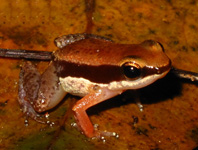Abstract
The specific status of several pygmy chameleons endemic to mountain massifs in the Eastern Arc Mountains, Tanzania has long been controversial due to their lack of distinctive morphological characters. In this work we extend our previous sampling of Rieppeleon and Rhampholeon species, especially from the Rhampoleon moyeri/Rhampholeon uluguruensis complex, and add data from a new mitochondrial marker to address this problem. Our results show that there is geographical structure between populations of pygmy chameleons from different mountains. This structure is especially well defined for Rhampholeon (Rhinodigitum). Phylogenetic analyses confirm that both Rh. uluguruensis Tilbury and Emmrich, 1995 and Rh. moyeri Menegon, Salvidio and Tilbury, 2002 are distinct lineages, the former from the Uluguru Mountains and the latter from the Udzungwa Mountains. However, the paratype material used to erect Rh. moyeri belongs to a separate lineage from the holotype. Similarly, a number of additional lineages within the Rh. moyeri/Rh. uluguruensis complex recovered in the analysis may deserve specific status. At present, there is a lack of morphological characters that can be used to distinguish these lineages, suggesting that there are multiple cryptic taxa in this complex.

